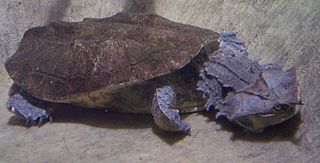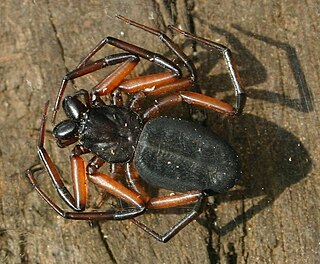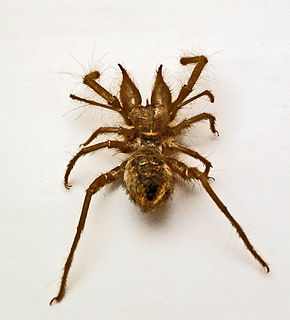
The family Psittacidae or parrots is one of three families of true parrots. It comprises the roughly 10 species of subfamily Psittacinae and 157 of subfamily Arinae, as well as several species that have gone extinct in recent centuries. Some of the most iconic birds in the world are represented here, such as the blue-and-gold macaw among the New World parrots and the grey parrot among the Old World parrots.

Chelidae is one of three living families of the turtle/tortoise suborder Pleurodira, and are commonly called Austro-South American side-neck turtles. The family is distributed in Australia, New Guinea, parts of Indonesia, and throughout most of South America. It is a large family of turtles with a significant fossil history dating back to the Cretaceous. The family is entirely Gondwanan in origin, with no members found outside Gondwana, either in the present day or as a fossil.

Eremobates is a genus of arachnids of the order Solifugae. About 2 inches long, these fast-moving arachnids have the largest jaw size to body ratio of any animal. They are not venomous, but have a remarkably powerful bite. Often hunting at night, they have poor eyesight and navigate mostly by use of a pair of pedipalps.

Solifugae is an order of animals in the class Arachnida known variously as camel spiders, wind scorpions, sun spiders, or solifuges. The order includes more than 1,000 described species in about 153 genera. Despite the common names, they are neither true scorpions nor true spiders. Most species of Solifugae live in dry climates and feed opportunistically on ground-dwelling arthropods and other small animals. The largest species grow to a length of 12–15 cm (5–6 in), including legs. A number of urban legends exaggerate the size and speed of the Solifugae, and their potential danger to humans, which is negligible.

In biology, a type is a particular specimen of an organism to which the scientific name of that organism is formally attached. In other words, a type is an example that serves to anchor or centralize the defining features of that particular taxon. In older usage, a type was a taxon rather than a specimen.

Gevuina avellana is an evergreen tree, up to 20 meters tall. It is the only species currently classified in the genus Gevuina. It is native to southern Chile and adjacent valleys in Argentina. It is found from sea level to 700 meters above sea level. Its distribution extends from 35° to 44° south latitude. The composite leaves are bright green and toothed, and the tree is in flower between July and November. The flowers are very small and beige to whitish, are bisexual and group two by two in long racemes. The fruit is a dark red nut when young and turns black. The peel is woody. It can grow up straight or branched from the soil, making up either a tree or a shrub.

Platyoides is a genus of spiders belonging to the family Trochanteriidae. Its members are known as scorpion spiders and are found in sub-Saharan Africa and its islands, Madagascar, Réunion, Aldabra and the Canary Islands.
Vinceria is an extinct genus of kannemeyeriiform dicynodont in the family Shansiodontidae. Fossils of the genus have been found in the Anisian Cerro de las Cabras Formation and Carnian Río Seco de la Quebrada Formation of Argentina. One species, C. argentinensis, named in 1966, was moved to its own genus, Acratophorus, in 2021. Another species, V. vieja, was merged with Acratophorus argentinensis in 2021, leaving V. andina as the only species in the genus.
Pascualgnathus is an extinct genus of traversodontid cynodonts from the Middle Triassic of Argentina. Fossils have been found from the Río Seco de la Quebrada Formation of the Puesto Viejo Group. The type species P. polanskii was named in 1966.

Chelypus ('clawfoot') is a genus of slow-moving, burrowing sunspiders confined to the deserts and arid regions of Southern Africa. There are 6 known species.

Huilatherium is an extinct genus of leontiniid, a group of hoofed mammals belonging to the order Notoungulata, that comprises other South American ungulate families that evolved in parallel with some mammals of the Northern hemisphere. The leontiinids were a family of herbivorous species comprising medium to large browsers, with relatively short skulls and robust limbs, somewhat similar to their relatives, the best known toxodontids.

Solpugidae is a family of solifuges or sun spiders. Solpugidae have groups of papillae on their pedipalps or sensory organs. The papillae come out of sockets that are characterized with the function of mechanoreceptor, and contact chemoreceptors, which allows them to respond to stimuli such as touch and sound.

The Solanaceae, or nightshades, are a family of flowering plants that ranges from annual and perennial herbs to vines, lianas, epiphytes, shrubs, and trees, and includes a number of agricultural crops, medicinal plants, spices, weeds, and ornamentals. Many members of the family contain potent alkaloids, and some are highly toxic, but many—including tomatoes, potatoes, eggplant, bell and chili peppers—are used as food. The family belongs to the order Solanales, in the asterid group and class Magnoliopsida (dicotyledons). The Solanaceae consists of about 98 genera and some 2,700 species, with a great diversity of habitats, morphology and ecology.

Phrynichidae is a family of arachnids.
Spiroctenus is a genus of African araneomorph spiders in the family Bemmeridae. It was first described by Eugène Louis Simon in 1889. Originally placed with the Ctenizidae, it was transferred to the funnel-web trapdoor spiders in 1985, and to the Bemmeridae in 2020. It is a senior synonym of Bemmeris, Bessia, and Ctenonemus.
Chanbria is a genus of camel spiders. It consists of four species found in the Sonoran Desert in Mexico and the southwestern United States.
Horribates is a genus of wind scorpions in the family Eremobatidae. At least three described species are placed in Horribates.

Protosolpuga carbonaria is an extinct species of solifuges, the only one of the genus Protosolpuga and the family Protosolpugidae. This Carboniferous camel spider was discovered in the Mazon Creek Formation in Illinois.












